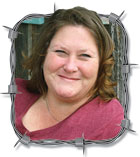I have played a round of golf once in my entire lifetime. It was the final class requirement for an eight-week golf class I took as a physical education elective my freshman year in college. I enjoyed it so much that I vowed never to pick up a golf club again. You see, I really did enjoy it, but after watching so many of my friends become addicted to the sport resulting in spending hundreds of dollars each year on equipment, fees and memberships, not to mention all the time they spend away from their families and jobs, I decided I might become “hooked” as well—and at that stage of my life, I could not afford the commitment of either money or time.
Lately, however, I’ve been regretting my lack of a recreational hobby. I had a good one when the boys lived at home and showed cattle all over the country. But now that they are gone it would just seem kind of pathetic for an old man to haul show cattle around from fair to fair just to have some entertainment. As my luck would have it, however, last week I discovered an entirely new sport that combines the skills and talents of golf with the everyday responsibilities of farming. I call it granger golf.
I farm in the Ozarks, so, needless to say, I have no land that would be considered anywhere near “flat.” Most of my land slopes from 5 percent to 10 percent but there are certainly parcels that slope upwards of 20 percent. It was on one of these steeper slopes that I was baling hay last week when the monitor beeper went off informing me that the bale was formed and would soon be automatically wrapped. Having ejected round bales that have rolled close to a quarter of a mile before, I knew there would be a problem if I unloaded the formed bale at this particular point. Looking around the baler, I saw a previously ejected bale about 100 yards below where I was. If I could hit it with the bale I was getting ready to unload, the bale wouldn’t be able to travel the next hundred yards and tear through the fence. It was a gamble, but what the heck—I needed some entertainment. I’d check my accuracy on the next round.
As I topped the hill, I began to think how stupid that was because if my rolling bale had missed the stationary bale, I would have had extra work in fixing the fence. Maybe I should have just taken up golf. Or maybe, I should just grow up!
Thirty minutes later when I made the turn to where I could see either the thrill of victory or the agony of defeat, I was amazed to see two bales so closely aligned, it looked as if they had been placed there with a front-end loader.
Smiling as I passed my “hole-in-one,” I was actually hoping the bale chamber would fill on this steep slope again. It did. Could I hit the two bales with this one? I was probably 20 yards farther up the hill, but I was on fire. Aim… and… open. This time, I couldn’t wait to see my success so I pulled the tractor and baler over to one side to watch the 1,000 pound projectile gain speed and head for “par 4 tenth hole.”
Perfection. Why did Phil Mikelsen ever call this a cruel sport?
On the next round, I could already envision four perfectly aligned bales, but as I neared the steep slope, I noticed that I needed more hay for the chamber to fill when I reached the sweet spot. Quickly, I doubled back on the adjoining winrow for a few feet to get some extra hay. It had been windblown and had some irregular swaths, but I thought I should come out about right to be able to empty at nearly the same spot as last time.
Aiming the rear of the baler toward my previous successes, I ejected and pulled the tractor over again only to watch a misshapen bale gain speed as it followed a perfect curve (just like the putting greens of Augusta National) changing from east to south and towards a recently constructed fence. The bale, traveling at an estimated 20 mph took out three fence posts and broke all but the bottom strand of barbed wire before jumping over a dozer pile sand trap and come to rest in my water hazard creek.
I can’t wait to play again because I’m confident that I’ll be better next time. It may be time to buy a new baler with a carbon graphite ejection gate.
Jerry Crownover is a farmer and a former professor of Agriculture Education at Missouri State University. He is a native of Baxter County, Arkansas, and an author and professional speaker. To contact Jerry about his books or to arrange speaking engagements, you may contact him by calling 1-866-532-1960 or visiting www.ozarksfn.com and clicking on 'Contact Us.'






